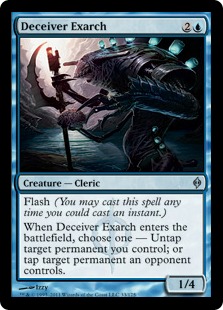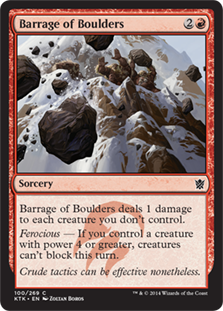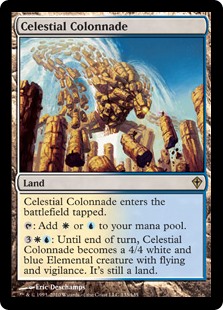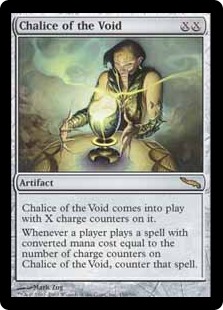Are you a Quiet Speculation member?
If not, now is a perfect time to join up! Our powerful tools, breaking-news analysis, and exclusive Discord channel will make sure you stay up to date and ahead of the curve.
Since I opened the Nexus discussion on Modern archetypes a couple weeks ago, community members have congregated in the comments section to share their opinions. The biggest argument against the theories I've proposed comes in the form of varying definitions of "fair" and "unfair." Today, I'll address those concerns more closely.

(This article is the third in a series on Modern archetypes and deck categorization. If you haven't read parts one and two, check them out first!)
[wp_ad_camp_1]
Fair is in the Eye of the Beholder
In my last article, I updated my definition of "unfair." For reference, here's that redraft:
How are Affinity and Infect unfair if they win by attacking opponents with creatures over the course of the game? To address this issue, I’ve added another framework. For me to consider a deck unfair, it must meet one or both of the following criteria:
- Has a reliable, nontraditional win condition
- Can go from “zero to hero”
The problem with this definition is the vagueness of "reliable." If a deck mostly attacks with creatures to win, but sometimes wins with a planeswalker, categorizing it as fair or unfair becomes a matter of deciding how often the planeswalker wins occur - or, how heavily the deck relies on them occurring.
 In Temur Twin, Tarmogoyf and Snapcaster Mage close out many of the games. The deck still differs from Temur Midrange since it has Splinter Twin. Running the combo package gives the deck help against strategies that invalidate the attacking strategy (Soul Sisters, Ensnaring Bridge), but it also buys tempo for the Twin player. Since opponents need to respect the Splinter Twin combo, they leave mana up that normally would have been spent on board presence, making even Deceiver Exarch a lot scarier in the red zone. In a perfect game, Temur Twin doesn't even need to combo off; it wins by Roasting threats, tapping down teams with Cryptic Command, and flipping Huntmaster of the Fells back and forth. Still, we can call Temur Twin's combo win condition reliable because the deck always leans on its existence. Its tempo game would be much worse than that of a Temur Delver deck if it weren't for the constant threat of an instant victory. Last week's system categorizes Temur Twin as an unfair deck, even though it plays lots of games fairly. But as described in part one, Temur Twin and other Aggro-Control-Combo decks usually play either fair or unfair games depending on the matchup, the game state, and their opening hands.
In Temur Twin, Tarmogoyf and Snapcaster Mage close out many of the games. The deck still differs from Temur Midrange since it has Splinter Twin. Running the combo package gives the deck help against strategies that invalidate the attacking strategy (Soul Sisters, Ensnaring Bridge), but it also buys tempo for the Twin player. Since opponents need to respect the Splinter Twin combo, they leave mana up that normally would have been spent on board presence, making even Deceiver Exarch a lot scarier in the red zone. In a perfect game, Temur Twin doesn't even need to combo off; it wins by Roasting threats, tapping down teams with Cryptic Command, and flipping Huntmaster of the Fells back and forth. Still, we can call Temur Twin's combo win condition reliable because the deck always leans on its existence. Its tempo game would be much worse than that of a Temur Delver deck if it weren't for the constant threat of an instant victory. Last week's system categorizes Temur Twin as an unfair deck, even though it plays lots of games fairly. But as described in part one, Temur Twin and other Aggro-Control-Combo decks usually play either fair or unfair games depending on the matchup, the game state, and their opening hands.
How much does Temur Twin rely on its combo finish? This question sounds a little confusing, because it is. "Reliable" is uncomfortably subjective, so we'll eliminate that qualifier from the definition, leaving us with this:
- Can go from “zero to hero"
Nobody disagreed with "zero to hero" indicating a deck's unfairness, but some pointed to decks like Merfolk that could set up a big board during a stall and then topdeck a Lord of Atlantis to swing in for an unblockable 20 points of damage. I still wouldn't call Merfolk a "zero to hero" deck; after a thousand games, the ones in which damage piles up over the course of multiple attacks should greatly outnumber those where it all happens in one turn.
 We can also apply the Merfolk example to other quintessentially fair decks. Consider a (very bad) Jund deck with Barrage of Boulders. It gets paired with an Abzan deck, and the two pile up Tarmogoyfs and Tasigurs and Siege Rhinos and Scavenging Oozes without ever attacking each other. If Jund draws Barrage of Boulders and crashes in for 20 damage, it didn't win in an "unfair way." By extension, the Jund deck doesn't become "unfair" when it starts running Barrage of Boulders. Granted, Merfolk achieves the "Barrage effect" pretty consistently with all those Spreading Seas, but the consistency of that kind of effect isn't what makes it unfair. It's still rare that the deck brings unharmed opponents to zero life in one turn.
We can also apply the Merfolk example to other quintessentially fair decks. Consider a (very bad) Jund deck with Barrage of Boulders. It gets paired with an Abzan deck, and the two pile up Tarmogoyfs and Tasigurs and Siege Rhinos and Scavenging Oozes without ever attacking each other. If Jund draws Barrage of Boulders and crashes in for 20 damage, it didn't win in an "unfair way." By extension, the Jund deck doesn't become "unfair" when it starts running Barrage of Boulders. Granted, Merfolk achieves the "Barrage effect" pretty consistently with all those Spreading Seas, but the consistency of that kind of effect isn't what makes it unfair. It's still rare that the deck brings unharmed opponents to zero life in one turn.
We're again caught up in the world of "reliable" here; if the deck goes zero to hero sometimes, where's the cutoff? I'm okay with this small hole in the theory. No theory is ever perfect, and I think it's pretty intuitive to look at Merfolk and Ad Nauseam and decide which of the two is unfair.
Out of Control!
Another concern with my definition of unfair was that it included Control decks. According to my definition, a "nontraditional" win condition was one that didn't involve or rely on creature combat. Since Jeskai Control often wins with reach (defined here as "noncombat damage") or planeswalkers, I figured it embodied the unfair spirit.
But I may have been quick to omit reach from "traditional." Tempo decks like Zoo and Delver play Lightning Bolt, and to an extent, "rely" on having that reach in-deck for the late-game. Jund, too, likes its Bolts to become kill spells for opponents once it has dealt with the board. I would never consider these decks unfair, so I'll consider reach traditional going forward.
 As for Jeskai Control, it's hard to call such an interactive deck unfair, especially when it plays out so similarly to other Midrange decks. The difference between Control and Midrange is that Control plans to disrupts opponents a prolonged amount of time before getting aggressive. While Midrange decks might wall Aggro decks with Tarmogoyf, Control decks prefer to one-for-one creatures with burn spells or wipe the board with Supreme Verdict. The Midrange deck can start attacking whenever it sees fit, as it already has Tarmogoyf on board. Jeskai might have a Celestial Colonnade on board, but animating the land not only takes longer, it requires a huge mana investment. Turning on Colonnade opens Jeskai Control players up to anything opponents have in store for them next turn. In practical terms, this means that Jeskai needs to wait until opponents are totally out of options, or until it reaches something like 10 mana, before attacking with the Colonnade safely.
As for Jeskai Control, it's hard to call such an interactive deck unfair, especially when it plays out so similarly to other Midrange decks. The difference between Control and Midrange is that Control plans to disrupts opponents a prolonged amount of time before getting aggressive. While Midrange decks might wall Aggro decks with Tarmogoyf, Control decks prefer to one-for-one creatures with burn spells or wipe the board with Supreme Verdict. The Midrange deck can start attacking whenever it sees fit, as it already has Tarmogoyf on board. Jeskai might have a Celestial Colonnade on board, but animating the land not only takes longer, it requires a huge mana investment. Turning on Colonnade opens Jeskai Control players up to anything opponents have in store for them next turn. In practical terms, this means that Jeskai needs to wait until opponents are totally out of options, or until it reaches something like 10 mana, before attacking with the Colonnade safely.
Still, the two play out similarly enough to blur the line between them. The difference is one of time: how long does the deck wait before it starts pursuing a victory directly? Since it's impossible to draw a clear line that isn't entirely arbitrary (i.e. "eight turns!"), I've finally given in and consider these decks fair.
Weissman vs. Prison
Up until now, we've only discussed Control decks of the Weissman variety. Michael Flores' "Finding the Tinker Deck," a 2003 article on historical archetypes that's as fun to read as it is tremendously dated, describes these decks as such:
"The Weissman deck (affectionately called The Deck) concentrated solely on defense; while most other players divided their resources between both offense and defense, this philosophy chose to concentrate almost exclusively on one side of the game only... effectively doubling their prowess in that regard."
Jeskai Control, with its range of answers and go-long plan, clearly falls into the Weissman Control archetype. The deck's interactive nature pushes it into fair territory. But some Control decks resist the fair label more than others. Here's Flores on the Prison archetype:
"Originally the Armageddon-packing Icy Manipulator + Icy Manipulator + Winter Orb lock foil of 1996, the Prison has grown into the archetype that epitomizes board control over true control. The Prison hates creature decks and tends to play way after way to answer attack-based threats. At the same time, it tends to be completely unable to defeat well-prepared Weissman-flavored control decks because so very many card slots are devoted to creature sanction. [...] In their focus on board control, from Chris Cade's original design forward, the Prison archetype has often boasted heavy mana control elements as well as creature defense."
I've left out Prison Control because it doesn't see much play in Modern. The closest we have are certain UBx Tezzeret, Agent of Bolas variants, WR Lockdown, and Lantern Control. These decks want to slam an early lock piece, like Chalice of the Void, Blood Moon, or Ensnaring Bridge, with the help of accelerants such as Mox Opal and Simian Spirit Guide. Many turns later, or less if they draw one sooner, these decks resolve a win condition and go to town on their devastated opponents.
 Prison has limited Modern exposure for a few reasons. For one, Modern-legal lock pieces don't always do much to tie up a game. Chalice on one crushes certain decks, like Infect and Delver, but fails to make a serious impact against any kind of Midrange strategy. Trinisphere suffers the same problem, but it also lets opponents draw out of the lock given enough turns. Blood Moon might hose Amulet Bloom and greedier opponents, but it's best used as a tempo tool in a format full of wary players fetching their basics. Modern opponents will eventually draw their basics, or their mana dorks, or their bounce spell, so Blood Moon doesn't usually end the game on its own; it requires pilots to back up its effect with pressure to end the game before opponents find an answer. In Legacy, where most spells cost a single mana and players stuff their manabases full of nonbasic lands, these lock pieces are far more effective.
Prison has limited Modern exposure for a few reasons. For one, Modern-legal lock pieces don't always do much to tie up a game. Chalice on one crushes certain decks, like Infect and Delver, but fails to make a serious impact against any kind of Midrange strategy. Trinisphere suffers the same problem, but it also lets opponents draw out of the lock given enough turns. Blood Moon might hose Amulet Bloom and greedier opponents, but it's best used as a tempo tool in a format full of wary players fetching their basics. Modern opponents will eventually draw their basics, or their mana dorks, or their bounce spell, so Blood Moon doesn't usually end the game on its own; it requires pilots to back up its effect with pressure to end the game before opponents find an answer. In Legacy, where most spells cost a single mana and players stuff their manabases full of nonbasic lands, these lock pieces are far more effective.
Secondly, accelerants like Chrome Mox and City of Traitors ensure the locks resolve early enough to do their work. Without relevant lock pieces like Tangle Wire and Winter Orb, or the bursts of speed afforded by Ancient Tomb and company, Modern Prison decks lack the tools to see widespread play. But however underrepresented, the archetype still exists, and I'd classify it as a proactive, linear, unfair breed of Control (compared with Weissman, a reactive, interactive, fair breed).
The format's highest-profile Prison deck is Lantern Control. Quickly looking over a sample list reveals both the deck's hardcore Control tendencies and its dissimilarity to any Weissman-style list. It hardly shares any cards with Modern's Snapcaster Mage-powered Control strategies, and though its gameplan is the same, its playstyle couldn't be any more unrelated. Like Weissman decks, Lantern Control wants to lock opponents out of a game and eventually kill them. It secures victories by milling opponents out while denying their relevant draws, and like most linear, unfair decks, folds to certain hate cards.
Even though Modern isn't home to many Prison strategies, I still think it's risky to call Control decks as a whole "fair," since some of them aren't.
Fairing it Out
As always, when we talk theory, it's important to reflect on our motivations. Since Tempo decks beat up on Control, I figured Control must be unfair - after all, my gorgeous diagram from last week explains that Tempo decks beat unfair decks, and Midrange decks take care of fair ones. Such an elegant model! In practice, though, it doesn't really work to attribute an unfair label to Control, or at least not to interactive subsections like Weissman.
I speak for myself and for many Magic personalities I've read over the last few years when I say ego sometimes plays a dangerous part in theory writing. My thanks goes out to this community in particular for helping me refine my outlook on the format. Hopefully, the discoveries we've made together will help others seeking guidance when navigating the vast world of deck archetypes.




I like the ongoing evolution of these articles, and I like the openness you’ve shown in putting aside your ego and focusing on making these as accurate and informative as possible. Hats off, man, these are becoming quite the resource to understand Magic deckbuilding on a theoretical level. I think that considering reach traditional is an excellent idea (given that it’s one of the major factors that separates successful aggro decks from the also-rans). I also find the differentiation between Weissman and prison control interesting, and probably necessary. As you said, Lantern Control and Jeskai Control want the same thing, but go about it in very different ways.
Provided these current definitions of fair/unfair and control stick… I would guess that combo’s next? If so, looking forward to it.
What’s about Aether Vial? For me it seems unfair that player can put creatures from his hand without spending mana for it and actually “casting” them. Said merfolks gain huge tempo cause of Vial effectively doubling their mana in certain circumstances. Still, the deck is purely fair one, I can’t agree more on that, but Aether Vial is not!
Aether Vial doesn’t allow players to win the game in an unfair way, so it’s not unfair. A better example of an unfair card is Ad Nauseam, which helps pilots win via nontraditional methods.
Cheating on mana is not unfair?
No, it’s a part of the game. Is Noble Hierarch unfair? How about Rampant Growth?
Using that logic: X combo piece is part of the game of magic, therefore it is not unfair.
Also to add on, Aether Vial ignores the fundamental rules of magic, it generates resources that seem go beyond a one card one mana investment. It allows you cast your creatures spells as uncounterable and gives all of your creatures flash.
Also to address on whether cheating on mana is unfair or not. If cheating on mana is not unfair, why is Chrome Mox banned in Modern? Seething Song?
Affinity is generally a restricted mechanic in modern with the artifact lands banned, and its a mechanic which essentially allows you to cheat on mana.
Why are Black Lotus, Lotus Pedal, Lion’s Eye Diamond, Mox Jet, Mox Pearl ect ect ect restricted in Vintage? The consensus seems to be that generating absurd amount of mana is in fact unfair.
Elvish Mystic/Noble Hiearch/rampant growth are probably “fixed” versions of their artifact counterparts. They require more resources and are more mana intense for the return that you receive.
Aether Vial and its ilk generate far more advantage over the course of the game or enable broken things that go beyond the investment of one/two card(s) and 0 or 1 mana should allow.
I clearly defined fair and unfair in the article and mana acceleration just doesn’t fall into the unfair category according to that definition. It’s fine if you have a different definition than me, but it’s natural that the article makes less sense if you choose to read it with your definition in mind and not mine. Check out parts 1 and 2 (linked above), and you can see the evolution of my definition over the last few weeks.
I have read your articles, here is a direct quote from you regarding ramp strategies:
“Ramp strategies occupy a strange place among Midrange decks, as it trades interaction for mana acceleration and expensive bombs. It ends up losing to Tempo, but beating other Midrange decks, as well as many Control strategies. Unlike other Midrange decks, Ramp strategies are unfair.”
I think the last sentence is rather pertinent, as what is ramp other than mana acceleration?
Just because a card is used in a fair deck does not mean that the card itself is in fact fair. Fair decks can contain unfair elements.
I’ll invite you to read the other articles, as my ramp definition has been redefined as the series progressed. There’s also a big different between running a set of Noble Hierarchs in an Aggro deck and dedicating a large chunk of your cards to mana acceleration. I’d be interested in seeing a list containing Aether Vial that you’d consider “Ramp.”
In your last article you still label ramp as unfair: “But these proactive, linear, and often unfair decks don’t fit smoothly into any of the hybrid categories discussed last week, so I move to bench the issue for now.”
You straw manned my statement. I merely compared Aether Vial to mana ramp strategies that you label as unfair, I never stated Aether Vial belonged in them.
While this is not directly related to the main topic, you did talk about Prison and Flores mentioned in his statement that it focuses on board control and in my opinion board control is what this game has become about and the most powerful decks are the majority of the time also the best decks focusing on controlling the board making dedicated Prison decks kinda superfluous.
I made a post on MTGSalvation about it and I don’t feel like typing all of that again and so will just copy it here.
Keep in mind that my post was in response to the statement that black has become the control color while blue has become the tempo color.
“And the reason for that is simple. Board-control is what this game has become about and black is far better suited for that than blue can ever hope to be. Simply because blue cannot actually interact with the board besides bouncing stuff which is notoriously bad outside of some tempo strategies since it’s card disadvantage.
It’s no coincidence that the best shells at board-control always find their way to the top and stay there. Mono-Black Devotion and Abzan as the most recent Standard examples and Jund, Abzan and nowadays also Grixis Control for Modern ones.
The receipt and basic principles are simple:
– I will simply deal with and remove your stuff.
Examples: Thoughtseize, Inquisition of Kozilek, Hero’s Downfall, Abzan Charm, Languish, Abrupt Decay, Ultimate Price, Bile Blight, Doom Blade, Terminate, Lightning Bolt, Liliana of the Veil, etc.
– I deploy my own stuff and the best thing about it is that it outclasses your stuff and makes it irrelevant. I don’t care about your Fleecemane Lions because you will never beat my Siege Rhinos or Elspeth, Sun’s Champions solely with them anyway.
Examples: Tarmogoyf, Siege Rhino, Desecration Demon, Pack Rat, Tasigur, the Golden Fang, Gurmag Angler, Elspeth, Sun’s Champion, Ugin, the Spirit Dragon, Olivia Voldaren, Scavenging Ooze, Thragtusk, etc.
Mono-Black Devotion really captured it the best. A mono-colored deck consisting of only 3 things: powerful and efficient removal/disruption, really powerful threats(I count Underworld Connections in this too) and lands to cast everything. So simple on the surface but it was enough to make it into the dominating monster that it was.
Jund in Modern was/is in the same boat. It was also dominating at one point and is still one of the best decks. It plays those 3 things too. It just needs to dip into 3 colors to get those things.
People wonder why Midrange specifically has become the most powerful archetype well here is why. It simply embodies this basic concept the best.”
Interesting take, but can we can agree on Lantern Control being a Prison deck? If so, Prison isn’t “dead” by any means, even if it’s lost a lot of steam or lacks it in Modern (same with dedicated Weissman decks). In general, as you noted, it’s just better to be more proactive in this format, which is why Midrange performs the best out of all the “Control” decks in Modern.
Indeed there are some prison decks with 8-Rack being another one of them but their meta-shares are so tiny that they might as well not exist. 8-Rack for example has a whopping 0.1%.
I think lacking is a bit of an understatement.
“Severely lacking” is still “lacking!” Pick any word you like, but at least to me, 0.1% and 0% are different. I’d say 8Rack, with its 0.1% share, is still more of a Modern deck than Blue-Red Minotaur Tribal (0%).
Is 8-rack a prison deck?
For sure, and I’m embarrassed for not having mentioned it in the article!
I’m curious as to what you would add to Flores’ archetype breakdown? Something for midrange is the only thing that design philosophy has really changed since it was written, otherwise the article mostly stands up to the test of time.
Hi Jordan,
I think it’s great that you’re being open to feedback and constantly evolving your definition with learning being the ultimate goal. I really appreciated the article. Thanks for your hard work here. 🙂